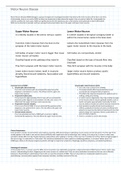Motor Neuron Disease
Motor Neuron Disease (MND) belongs to a group of progressive neurological disorders that destroy the motor neurons of the brain over time.
Unfortunately, there is no cure for MND, but there are treatments to help reduce the impact it has on a person's daily life. Some people live
with the condition for many years. MND can significantly shorten life expectancy and, unfortunately, eventually leads to deat h (NHS,2022).
MND can be inherited or sporadic and have varying clinical presentations due to the upper and lower motor neurons.
Common Forms of MND: Amyotrophic Lateral Sclerosis (ALS):
1. Amyotrophic lateral sclerosis: • This is the most common form of MND.
This is the most common with an estimated life expectancy after • This predominantly affects pyramidal features and
diagnosis to be between 2-5 years. This affects both the upper and occasionally has extrapyramidal components.
lower motor neurons. • This affects the voluntary movement of a patient such as
2. Progressive bulbar palsy: walking, talking and chewing.
This accounts for approximately 25% of cases with an estimated life • As motor neurons degenerate, they stop sending messages
expectancy after diagnosis to be between 6 months and 3 years. This to the muscles and the muscles gradually weaken, start to
affects both the upper and lower motor neurons also. twitch, and waste away (atrophy). Eventually, the brain
3. Progressive muscular atrophy: loses its ability to initiate and control voluntary movements.
This is a rarer from of MND. It has an estimated life expectancy after • Early symptoms usually include muscle weakness or
diagnosis to be upwards from 5 years. This also affects the upper and stiffness, gradually all voluntary muscles are affected and
lower motor neurons. patients can even lose the ability to breathe with most ALS
4. Primary lateral sclerosis: patients dying from respiratory failure usually within 3-5
This is an extremely rare form of MND with a normal or slightly years of initial symptoms.
shortened life expectancy. This only affects the upper motor neurons. • There is currently no cure for this disease.
Clinical Presentation:
Early symptoms include, muscle twitches and weakness, spasticity, difficulty chewing or swallowing, muscle cramps and slurred speech. The first sign of ALS
usually appears in the hand or arm and can show as difficulty with simple tasks such as buttoning a shirt, writing, or turning a key in a lock. In other cases,
symptoms initially affect one leg. People experience awkwardness when walking or running, or they may trip or stumble more of ten. When symptoms begin in
the arms or legs, it is referred to as “limb onset” ALS, and when individuals first notice speech or swallowing problems, it is termed “bulbar onset” ALS
(NINDS.gov, 2022). As the disease progresses patients will begin to experience symptoms of dysphagia, dysarthria, dyspnoea, a nd dyskinesia/Akinesia.
Pathology & Treatment:
Unfortunately there is no known cause for MND. Some researchers have identified some genetic components linked to MND however there is still no clear
cause or understanding of what is happening to the motor neurons at a cellular level. There are some medication interventions that can such as Riluzole,
Edaravone, Muscle Relaxers and Botulinum toxin with can ease the symptoms of MND. There are also other non-medicated treatments such as
physiotherapy, communication support (brain-computer interface), ventilators and end of life care.
Neurological Conditions Page 1




